What varieties of watermelons are preferable for planting in Siberia
Watermelon, like any other melon culture, loves warmth and light. Watermelons are grown on spacious and loose lands in regions with long and hot summers. However, some varieties were bred specifically for cultivation in Siberia, a region that cannot boast of long warmth and long daylight hours.
In the article, we will consider which hybrids and varieties of watermelons are preferable to plant in Siberia and what recommendations to follow when planting.
The content of the article
Features of growing watermelons in Siberia
Experienced farmers recommend paying special attention to agrotechnical rules when growing watermelons in Siberia... It is important to provide the plant with balanced nutrition, proper watering, and timely loosening.
 Melons are planted in seedlings. This strengthens the plant's immunity and helps watermelons adapt to climatic conditions faster. The plant must be immune to extreme weather changes, lingering fogs and rain.
Melons are planted in seedlings. This strengthens the plant's immunity and helps watermelons adapt to climatic conditions faster. The plant must be immune to extreme weather changes, lingering fogs and rain.
The landing procedure and pattern are important. Before sowing, the seeds and beds must be disinfected, the distance between the bushes is observed.
Cold-resistant varieties of watermelons
Consider a description of popular varieties of watermelon for Siberia, find out their distinctive features, advantages and rules of cultivation.
Chill
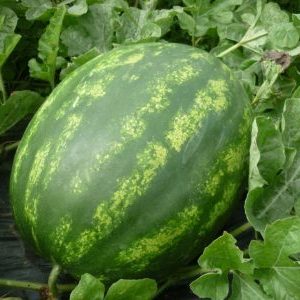
Grow grade on private plots and spacious farm fields. Refers to mid-late, the first crop is harvested 3 months after germination.
Chill is suitable for growing in greenhouses and in the open field. The bush is powerful, the shoots are long and strong. The shape of the fruit is round, weight 4-5 kg.
The peel is green in a mesh, the flesh is sugary and dense. The taste is sweet and juicy, with a strong aroma.
The yield is stable, about 7 kg are harvested from 1 m².
Ultra early

The variety is unpretentious in care, it has compact bushes and short shoots.
Watermelon is planted with seedlings, the harvest is harvested in 75-85 days.
Fruits are spherical, green. The weight of one is about 5 kg. The pulp is tender, raspberry hue.
Ultra-early is resistant to tobacco mosaic and root rot; in order to obtain a rich harvest, it is recommended to grow it in greenhouse conditions.
From 1 m² collect from 4 to 7 kg.
Interesting! Watermelon contains vitamins A, B, C, E, trace elements, acids and dietary fiber. It has a strong diuretic effect, improves metabolism.
Photon
Foton watermelon ripens in 85-100 days. The early-ripening variety is resistant to sudden changes in the weather, suitable for planting in greenhouses or outdoors. Fruits are roundish, light green color with dark stripes.
The weight of a watermelon is about 4 kg, in some cases it reaches 6-7 kg. The pulp is red with small black seeds. Watermelon tastes mild and sweet. The fruiting period is extended, the fruit ovary is friendly.
Charleston Gray
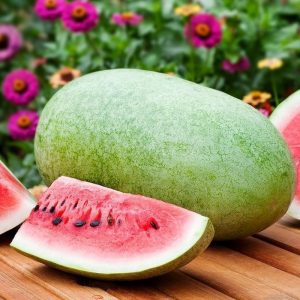
The French hybrid became famous for its unusual elongated shape. Ripens in 75 days from the moment of planting on large bushes with long and powerful shoots. The fruits are heavy, weighing 12-16 kg. The color is green, striped. The pulp is bright pink, sweet and juicy.
Charleston Gray has an elastic and dense rind, thanks to which the watermelon retains its marketable appearance and taste for up to 40-50 days. The variety is resistant to fusarium wilt and mosaic, rarely exposed to invasions of insect pests.
Superearly Dutina
The variety got its name due to its super-early ripening period - beautiful and juicy fruits appear on the beds 60-70 days after the germination of the first shoots. The plant is miniature, but the lashes are long and strong, reaching 2 m.
The shape is spherical, the surface is green, with dark and light stripes. Fruit weight 4-6 kg. The taste is excellent, the pulp is granular and sugary. Superearly Dyutina is universal in use: jam and compotes, fruit salads and snacks are prepared from watermelon.
Siberian lights
A high-yielding and unpretentious cultivar, it ripens in 80-90 days. The fruits are small, the weight of one is about 2-3 kg. The peel is green with a dark stripe. The taste is sweet, the aroma is pleasant.
The Siberian Lights variety is resistant to cool climates, frequent winds and fogs. Possesses attractive commercial qualities, suitable for long-term storage and transportation over long distances.
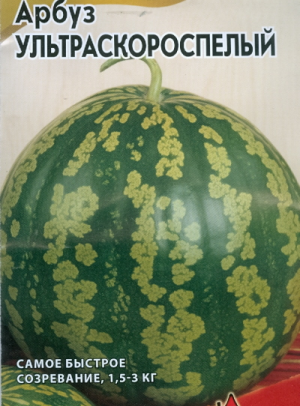
Ultra-ripe
The fruits are dark green, with subtle thin stripes on the surface. The mass of a watermelon is about 3-4 kg. Grown in open and closed ground, Ultra-early ripening in 60-70 days.
The variety is characterized by cold resistance and immunity to common pests of melons and gourds. The pulp is bright red with a granular structure and a juicy taste. 2-3 kg are collected from 1 m².
Eureka f1
The hybrid is intended for growing in film or greenhouse shelters... The plant is sprawling, has a powerful and large root system. Watermelon Eureka ripens in 60-70 days. Fruits of traditional round shape, weight from 10 to 15 kg.
Gardeners appreciate Eureka for its high commercial qualities, juicy and tender pulp, and ease of cultivation. Harvest is used for fresh consumption and preparation of sweet fruit dishes.
Crimson Sweet
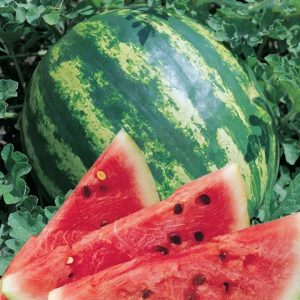
Early ripe Crimson Sweet ripens in 75-85 days. Fruit weight from 5 to 13 kg, spherical shape. The pulp is deep red, sugary and very sweet.
Differs in uniformity, low seed content and crunchy taste. The rind is of medium density, matte and even. Crimson Sweet is resistant to bacteriosis and root rot, and does not require special agrotechnical knowledge and skills in care.
Productivity depends on timely watering and application of mineral and organic fertilizers.
Kai f1
In Siberia, this popular hybrid is planted in seedlings. Kai refers to early ripening watermelons, ripens in 65 days from the moment the first shoots appear.
Fruits are oval-elongated, weight 7-10 kg. The pulp is a classic pink shade, the seeds are small, black-brown in color. The surface is green, with light ribbing and light wide stripes. On the inside, the crust is thin, white.
Watermelon is good fresh and is used for conservation. It is famous for its delicate and sweet rich taste.
Suga Baby
Ripens in 75-85 days, unpretentious, suitable for growing outdoors and in greenhouses. The lashes are long and powerful, the fruits ripen gradually. Productivity is high, from 1 m² - from 12 kg. The shape is oval, slightly flattened at the sides. Weight 3-6 kg, flesh is bright red. The taste is sweet and honeyed. There are few seeds.
Interesting! Boiled from watermelon peels jam... It is enough to prepare a syrup from water and sugar, in which the crusts languish for 2-5 hours. The treat acquires a brown tint, the crusts retain benefits and vitamins.
Twinkle
Watermelon Spark unpretentious in cultivation, they are planted by seeds in open ground or by seedling. Fruits are compact, up to 2 kg. They have a dense and resilient peel, they perfectly tolerate long-term transportation. Spherical shape, green color. The pulp is fibrous, sweet and aromatic. In application, the Ogonyok variety is universal.
Astrakhan
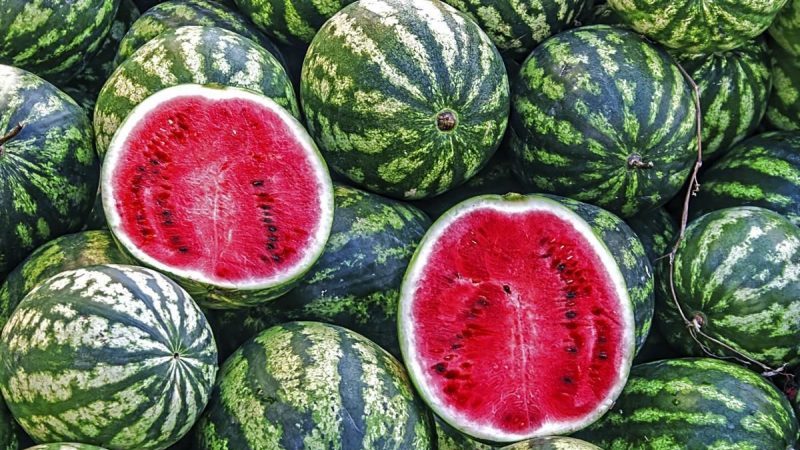
The well-known Astrakhan watermelon is also grown in cool Siberia. Fruits are large, maximum weight 8 kg. The shape is rounded, on the surface there are wide green stripes. The seeds are large, black-brown in color. The pulp is granular, honey. Astrakhan watermelon has an appetizing appearance and is well transported over long distances.
Siberian
The name of the variety speaks for itself - unpretentious, resistant to cool climates and diseases. The shape is spherical, the peel is matte, dark green. The weight of one fruit is 2-3 kg. Sibiryak ripens in 80-90 days from the moment the first shoots appear. Suitable for growing in greenhouses and greenhouses. Watermelon Sibiryak is cultivated on an industrial scale for sale.
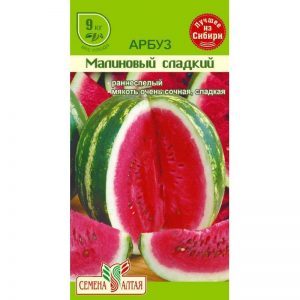
Raspberry sweet
Easy to clean Raspberry sweet ripens in 3 months. The plant is semi-sprawling, medium-sized lashes.
Raspberry sweet is a miniature fruit weighing up to 2 kg and juicy pink flesh.
The variety does not require special care in the form of formation or garter; it is enough to water and loosen the beds in a timely manner.
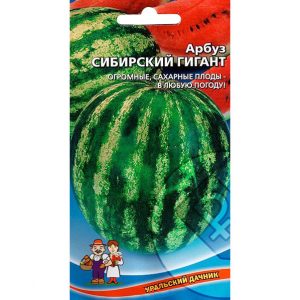
Siberian giant
Green fruits weigh 7-8 kg, the surface is glossy with a dark-light green strip.
The Siberian giant is cold-resistant, but it is recommended to plant it in greenhouses to obtain a rich harvest.
Thanks to the dense skin, the crop is stored for a long time. The taste is sugary, universal in application. Watermelon ripens in 3-3.5 months.
Sugar baby
Ultra Early Sugar Baby ripens in 75-80 days. Grown in the open field, the plant rarely gets sick.
The shape is spherical, the peel is glossy, dark green with thin black stripes. The mass of the watermelon is about 1 kg, the taste is classic, sweet. In some cases, the fruits grow up to 4-6 kg.
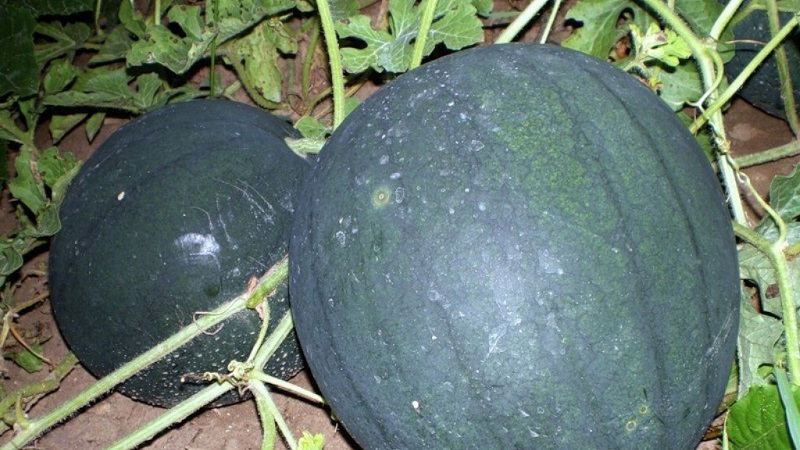
Growing conditions in Siberia
We will learn the agrotechnical secrets of experienced gardeners and find out which type of watermelon is preferable to plant in Altai, Siberia and the Urals.
When is the best time to plant
Watermelon seedlings are planted at the end of March. Some gardeners are guided by the lunar calendar or the experience of past years. For planting, seeds, seedling capacity and soil are purchased in advance. The optimal time for planting watermelon seedlings is from March 25 to April 10.
Rules and schemes for planting seeds for seedlings
Before planting, the seeds are disinfected with a weak solution of succinic acid or with the drug "Epin". The container is washed with clean water and wiped dry with a towel, the soil is disinfected by heating in the oven. The container is filled with earth and grooves are made at a distance of 7-10 cm from each other. It is not recommended to sow seeds too close to each other, as a thickened planting leads to the development of diseases and pests.
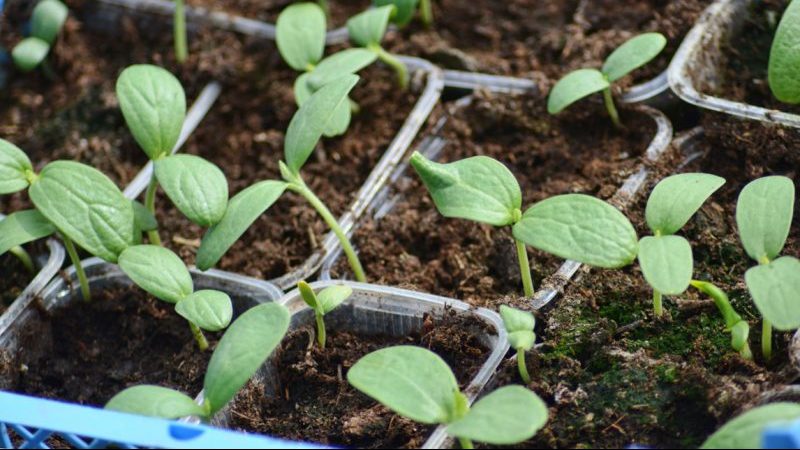
Seedling care and preparation for planting in open ground
Seedling care consists of watering, fertilizing and observing daylight hours.
Experienced summer residents advise:
- water the seedlings 1 time in 5 days with warm water;
- direct water to the root, bypassing leaves and stems;
- organize the plant daylight hours at least 12 hours;
- with a lack of light, purchase a phytolamp;
- spray the seedlings with a spray bottle once a week;
- apply the first top dressing 15 days after planting;
- fertilize watermelons with urea, liquid chicken droppings and ammonium nitrate;
- stop watering 5 days before planting in the garden.
Transplanting seedlings into open ground
Before planting, the beds are prepared: they dig up the ground, clean it of debris, weeds and the remains of last year's plants. Planting density depends on the variety, on average it is a 1x1 scheme. Depressions are made in the beds, filled with water.
The seedlings are carefully removed from the seedling container and placed in the ground, sprinkling the base of the stem with river sand, soil and dry sawdust. In the first week, the plants are covered with polyethylene to protect them from rain and wind.
Outdoor watermelon care
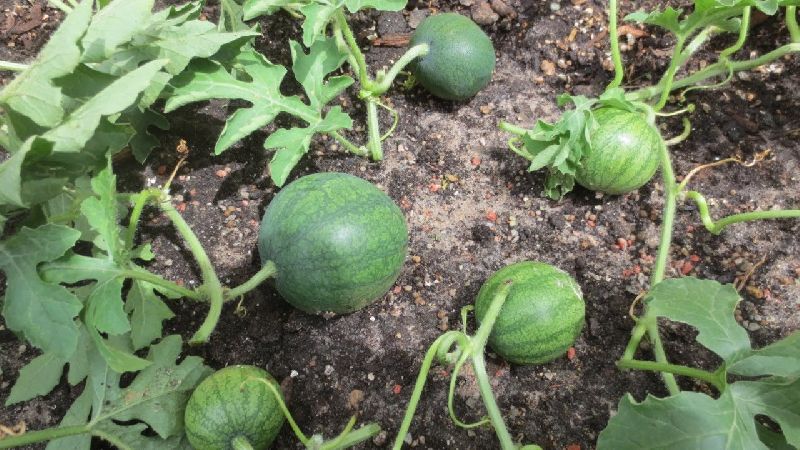
Competent care is the key to a rich harvest. Care should be timely and regular:
- Watering beds - 1 time per 4-5 days. For watering, choose early morning or evening to avoid sunburn.
- Fertilizer organic and mineral dressings. They use yeast, urea, manure, compost, superphosphate. They improve the taste and marketability of the fruit. Top dressing is applied once every 15 days.
- Protection against diseases and pests consists of spraying with Bordeaux liquid or a solution of copper sulfate.
- Formation of bushes ensures the development of large fruits. In the process of formation, 1-2 large stems are left, the remaining side shoots are removed, and the top is pinched.
- Loosening the earth improves the quality of the soil, making it nutritious and light. More oxygen is supplied to the roots of the plant. They loosen the beds before watering.
- Pollinate watermelons, bees, bumblebees and other insects. Growth watermelon berries will begin only after pollination. If the plant is in a greenhouse, manual pollination will help. It is carried out in the early morning with a brush or cotton swab: pollen from male flowers is transferred to female ones.
Harvesting and storage
Harvested in late August - early September. Ripeness is determined by the dull sound when tapped, the glossy shine of the peel, the elasticity of the fruit. After harvesting, wipe the watermelons with a dry napkin.
For long-term storage, the crop is placed in a dry cellar or basement with good ventilation and an air humidity of no more than 80%.
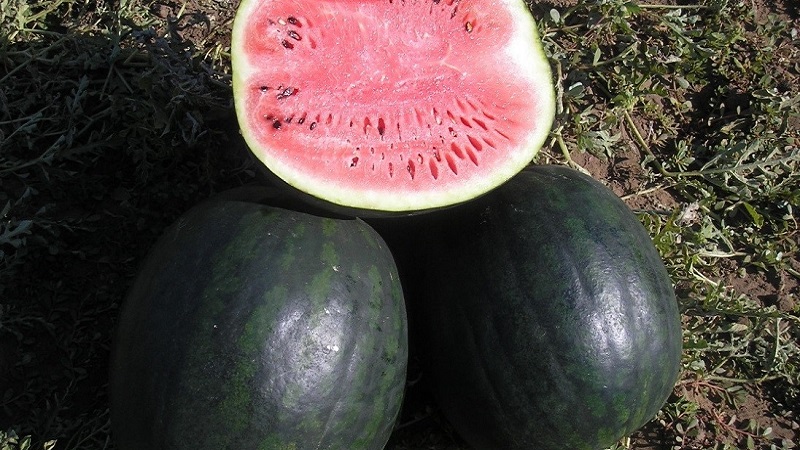
Conclusion
For the cultivation of sweet watermelon in Siberia, cold-resistant varieties with increased immunity to diseases and pests are chosen. Astrakhansky, Sibiryak, Suga Baby - these watermelons became famous due to their high immunity and early maturity.
The seedling method of planting and preliminary disinfection of seeds and soil will help to improve the amount of harvest. Suitable areas for growing melons are hilly beds away from groundwater.